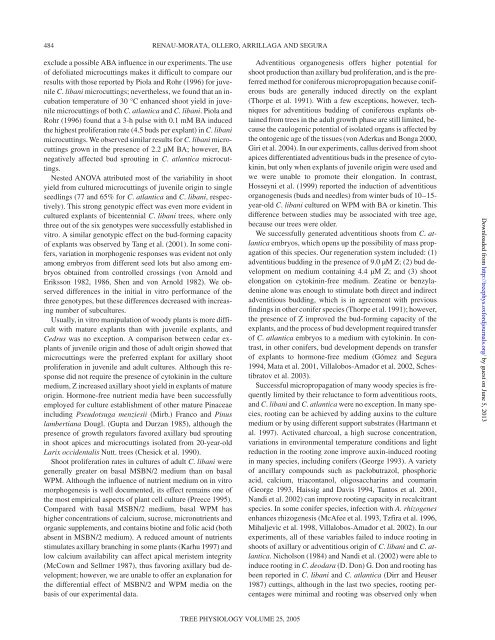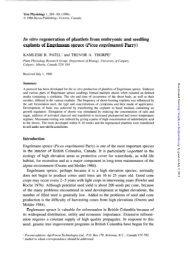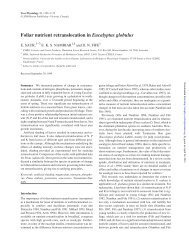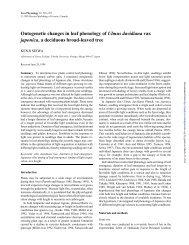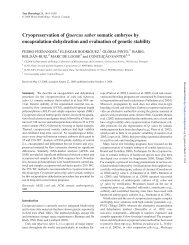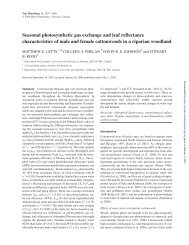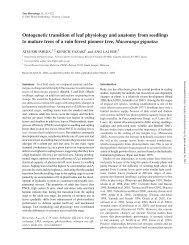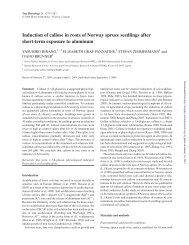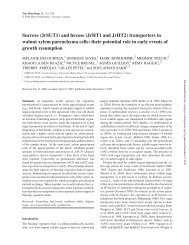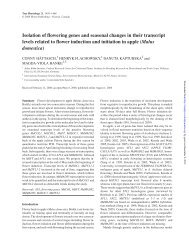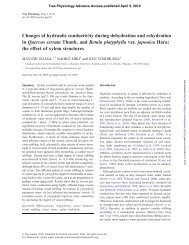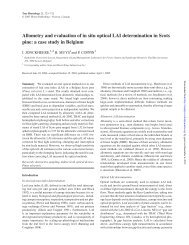Factors influencing axillary shoot proliferation and ... - Tree Physiology
Factors influencing axillary shoot proliferation and ... - Tree Physiology
Factors influencing axillary shoot proliferation and ... - Tree Physiology
You also want an ePaper? Increase the reach of your titles
YUMPU automatically turns print PDFs into web optimized ePapers that Google loves.
484 RENAU-MORATA, OLLERO, ARRILLAGA AND SEGURA<br />
exclude a possible ABA influence in our experiments. The use<br />
of defoliated microcuttings makes it difficult to compare our<br />
results with those reported by Piola <strong>and</strong> Rohr (1996) for juvenile<br />
C. libani microcuttings; nevertheless, we found that an incubation<br />
temperature of 30 °C enhanced <strong>shoot</strong> yield in juvenile<br />
microcuttings of both C. atlantica <strong>and</strong> C. libani. Piola <strong>and</strong><br />
Rohr (1996) found that a 3-h pulse with 0.1 mM BA induced<br />
the highest <strong>proliferation</strong> rate (4.5 buds per explant) in C. libani<br />
microcuttings. We observed similar results for C. libani microcuttings<br />
grown in the presence of 2.2 µM BA; however, BA<br />
negatively affected bud sprouting in C. atlantica microcuttings.<br />
Nested ANOVA attributed most of the variability in <strong>shoot</strong><br />
yield from cultured microcuttings of juvenile origin to single<br />
seedlings (77 <strong>and</strong> 65% for C. atlantica <strong>and</strong> C. libani, respectively).<br />
This strong genotypic effect was even more evident in<br />
cultured explants of bicentennial C. libani trees, where only<br />
three out of the six genotypes were successfully established in<br />
vitro. A similar genotypic effect on the bud-forming capacity<br />
of explants was observed by Tang et al. (2001). In some conifers,<br />
variation in morphogenic responses was evident not only<br />
among embryos from different seed lots but also among embryos<br />
obtained from controlled crossings (von Arnold <strong>and</strong><br />
Eriksson 1982, 1986, Shen <strong>and</strong> von Arnold 1982). We observed<br />
differences in the initial in vitro performance of the<br />
three genotypes, but these differences decreased with increasing<br />
number of subcultures.<br />
Usually, in vitro manipulation of woody plants is more difficult<br />
with mature explants than with juvenile explants, <strong>and</strong><br />
Cedrus was no exception. A comparison between cedar explants<br />
of juvenile origin <strong>and</strong> those of adult origin showed that<br />
microcuttings were the preferred explant for <strong>axillary</strong> <strong>shoot</strong><br />
<strong>proliferation</strong> in juvenile <strong>and</strong> adult cultures. Although this response<br />
did not require the presence of cytokinin in the culture<br />
medium, Z increased <strong>axillary</strong> <strong>shoot</strong> yield in explants of mature<br />
origin. Hormone-free nutrient media have been successfully<br />
employed for culture establishment of other mature Pinaceae<br />
including Pseudotsuga menziesii (Mirb.) Franco <strong>and</strong> Pinus<br />
lambertiana Dougl. (Gupta <strong>and</strong> Durzan 1985), although the<br />
presence of growth regulators favored <strong>axillary</strong> bud sprouting<br />
in <strong>shoot</strong> apices <strong>and</strong> microcuttings isolated from 20-year-old<br />
Larix occidentalis Nutt. trees (Chesick et al. 1990).<br />
Shoot <strong>proliferation</strong> rates in cultures of adult C. libani were<br />
generally greater on basal MSBN/2 medium than on basal<br />
WPM. Although the influence of nutrient medium on in vitro<br />
morphogenesis is well documented, its effect remains one of<br />
the most empirical aspects of plant cell culture (Preece 1995).<br />
Compared with basal MSBN/2 medium, basal WPM has<br />
higher concentrations of calcium, sucrose, micronutrients <strong>and</strong><br />
organic supplements, <strong>and</strong> contains biotine <strong>and</strong> folic acid (both<br />
absent in MSBN/2 medium). A reduced amount of nutrients<br />
stimulates <strong>axillary</strong> branching in some plants (Karhu 1997) <strong>and</strong><br />
low calcium availability can affect apical meristem integrity<br />
(McCown <strong>and</strong> Sellmer 1987), thus favoring <strong>axillary</strong> bud development;<br />
however, we are unable to offer an explanation for<br />
the differential effect of MSBN/2 <strong>and</strong> WPM media on the<br />
basis of our experimental data.<br />
TREE PHYSIOLOGY VOLUME 25, 2005<br />
Adventitious organogenesis offers higher potential for<br />
<strong>shoot</strong> production than <strong>axillary</strong> bud <strong>proliferation</strong>, <strong>and</strong> is the preferred<br />
method for coniferous micropropagation because coniferous<br />
buds are generally induced directly on the explant<br />
(Thorpe et al. 1991). With a few exceptions, however, techniques<br />
for adventitious budding of coniferous explants obtained<br />
from trees in the adult growth phase are still limited, because<br />
the caulogenic potential of isolated organs is affected by<br />
the ontogenic age of the tissues (von Aderkas <strong>and</strong> Bonga 2000,<br />
Giri et al. 2004). In our experiments, callus derived from <strong>shoot</strong><br />
apices differentiated adventitious buds in the presence of cytokinin,<br />
but only when explants of juvenile origin were used <strong>and</strong><br />
we were unable to promote their elongation. In contrast,<br />
Hosseyni et al. (1999) reported the induction of adventitious<br />
organogenesis (buds <strong>and</strong> needles) from winter buds of 10–15year-old<br />
C. libani cultured on WPM with BA or kinetin. This<br />
difference between studies may be associated with tree age,<br />
because our trees were older.<br />
We successfully generated adventitious <strong>shoot</strong>s from C. atlantica<br />
embryos, which opens up the possibility of mass propagation<br />
of this species. Our regeneration system included: (1)<br />
adventitious budding in the presence of 9.0 µM Z; (2) bud development<br />
on medium containing 4.4 µM Z; <strong>and</strong> (3) <strong>shoot</strong><br />
elongation on cytokinin-free medium. Zeatine or benzyladenine<br />
alone was enough to stimulate both direct <strong>and</strong> indirect<br />
adventitious budding, which is in agreement with previous<br />
findings in other conifer species (Thorpe et al. 1991); however,<br />
the presence of Z improved the bud-forming capacity of the<br />
explants, <strong>and</strong> the process of bud development required transfer<br />
of C. atlantica embryos to a medium with cytokinin. In contrast,<br />
in other conifers, bud development depends on transfer<br />
of explants to hormone-free medium (Gómez <strong>and</strong> Segura<br />
1994, Mata et al. 2001, Villalobos-Amador et al. 2002, Schestibratov<br />
et al. 2003).<br />
Successful micropropagation of many woody species is frequently<br />
limited by their reluctance to form adventitious roots,<br />
<strong>and</strong> C. libani <strong>and</strong> C. atlantica were no exception. In many species,<br />
rooting can be achieved by adding auxins to the culture<br />
medium or by using different support substrates (Hartmann et<br />
al. 1997). Activated charcoal, a high sucrose concentration,<br />
variations in environmental temperature conditions <strong>and</strong> light<br />
reduction in the rooting zone improve auxin-induced rooting<br />
in many species, including conifers (George 1993). A variety<br />
of ancillary compounds such as paclobutrazol, phosphoric<br />
acid, calcium, triacontanol, oligosaccharins <strong>and</strong> coumarin<br />
(George 1993, Haissig <strong>and</strong> Davis 1994, Tantos et al. 2001,<br />
N<strong>and</strong>i et al. 2002) can improve rooting capacity in recalcitrant<br />
species. In some conifer species, infection with A. rhizogenes<br />
enhances rhizogenesis (McAfee et al. 1993, Tzfira et al. 1996,<br />
Mihaljevic et al. 1998, Villalobos-Amador et al. 2002). In our<br />
experiments, all of these variables failed to induce rooting in<br />
<strong>shoot</strong>s of <strong>axillary</strong> or adventitious origin of C. libani <strong>and</strong> C. atlantica.<br />
Nicholson (1984) <strong>and</strong> N<strong>and</strong>i et al. (2002) were able to<br />
induce rooting in C. deodara (D. Don) G. Don <strong>and</strong> rooting has<br />
been reported in C. libani <strong>and</strong> C. atlantica (Dirr <strong>and</strong> Heuser<br />
1987) cuttings, although in the last two species, rooting percentages<br />
were minimal <strong>and</strong> rooting was observed only when<br />
Downloaded from<br />
http://treephys.oxfordjournals.org/ by guest on June 5, 2013


